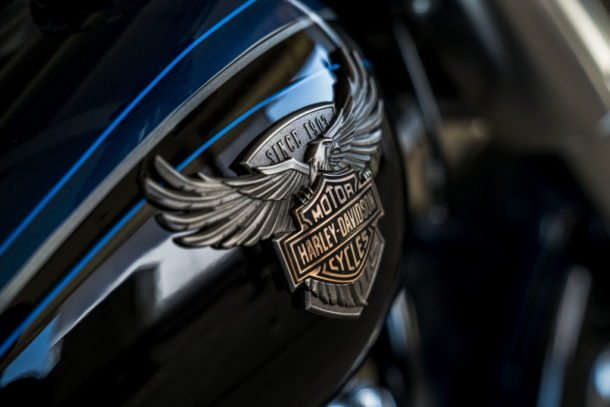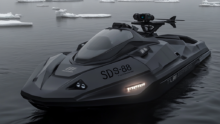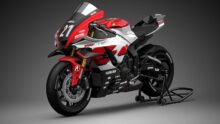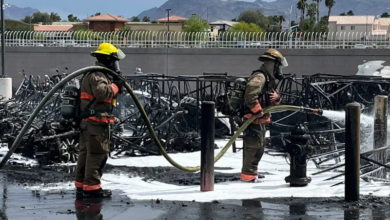December Snow Bumps Some Sales in Snowbelt
There are, of course, other reasons dealers gave for good sales (advertising efforts, exciting product) and for poor sales (depressed economies, machine prices), but each dealer cited snow as the top instigator for customer traffic and sales.
“I’ve been doing my snow dance,” said Bob Bott of Bott Yamaha-Bombardier, Idaho Falls, Idaho. “Snow is what really keeps things going.”
SNOW EQUALS SALES
Pre-Christmas sales were bolstered by early December snowfall, but warming trends across much of the snowbelt now have dealers in a post-holiday blues.
“The first three weeks in December were phenomenal,” said Carl Mason, owner of Bright Powersports in Lincoln Park, Mich. “I was selling two or three a day. Now I have not sold a sled in two weeks.”
Mason sells Arctic Cat, Ski-Doo and Yamaha. In the early ’90s, he sold 300 units; this year he’s hoping for 50.
It’s the same for Avenue Lawn & Leisure, a Ski-Doo and Polaris dealer in Menomonee Falls, Wis. Marty Hitzeman, of the service department, summed sales up in one word: “Bad.”
“It was good in early December when we had all the snow, but there’s no snow anywhere now,” he said, adding that on good days, they’d sell three or four machines. “This week it was two, last week there were none,” he said. The dealership typically sells about 100 new and used units annually.
Dealerships who are in marginal or typical no-snow areas still report snowfall is a major contributor to dealer traffic.
For Planet Powersports, just north of the Indiana border, a dearth of snow within a reasonable driving range has inhibited sales. Ditto for Bright Powersports, south of Detroit. Typically, rideable snow is within 3 hours; now it’s more like 15.
“When there’s more snow, there’s more impulse buyers,” Mason said.
Mason said he’s going to clear out his inventory no matter what. “I’m going to sell below cost so I don’t have to pay interest on it,” he said. “It isn’t a good business strategy.”
Sweet of Planet Powersports said area economics have taken a toll on potential buyers. “It’s affected people. I’ve had about a half-dozen customers who’ve sold their stuff because of gas prices and the economy in general,” Sweet said. “I’ve had more calls from people off the street saying, ‘I have a four-place trailer, four sleds and I’m getting out of it.’”
Planet Powersports sells all four snowmobile brands, and generally turns 800 new sleds annually. Sweet declined to give numbers, but said sales are off significantly.
The most chipper dealers were the ones that could look outside and see snow, or who were in close proximity to rideable areas.
Dean Walts, owner of the Ski-Doo/Yamaha dealership Dalton Mountain Motor Sports in Lancaster, N. H., was certainly happy.
“We’re the place people trailer to,” he said. There’s at least a foot of snow outside his dealership, and several feet in higher elevations. He typically sells 400 new units and 150 used annually. Right now, he’s down to about 150 machines remaining.
“We were going along at honorable mention sales until about two weeks ago and then things started going really well,” Walts said. “We’re averaging about five a day, some days as high as 20. We have not gotten skunked in a long time.”
Bott in Idaho Falls, Idaho, also reports good sales this year, even with some hefty price tags.
“The $10,000 to $12,000 price tags haven’t really slowed (buyers) down much,” Bott said. “It’s kind of surprising.”
Bott said his sales fell off last year after Christmas; not so this year. Bott averages selling 100 new machines annually. He has about 15 to 20 new units remaining and 40 used machines in his inventory.
Weller’s dealership, which deals in Polaris, Ski-Doo and Yamaha, generally sells between 170 and 200 new units annually. This year, Weller said, sales are closer to the 200 end of the spectrum. He sells mostly mountain-specific machines.
“We had excellent snow last year, and that excitement follows from year to year,” he said. “And then there’s the product. Product is king.”
In Weller’s kingdom, it’s Ski-Doo that rules. “I’ve already sold out of Ski-Doos twice and brought more in.” He started off with 150, and even with the late additions, he has about five sitting in the showroom. He’s selling Summits on the REV platform, mostly in the 800cc class.
Any longtrack on a REV platform sells, he said, whether it’s new or used. “That REV is a fun sled, and it has brought the fun aspect back to snowmobiling, and that’s the customers’ perception,” he said. “That’s why I think my sales are up with Ski-Doo. My sales with Yamaha and Polaris are totally flat.”
Yamaha’s latest entry into the mountain segment, the four-stroke Apex Mountain, is turning some heads, though customers are still concerned with its weight. Weller estimates Yamaha sales make up 2 to 3 percent of his overall sales. “(The Apex Mountain) is lightyears ahead of the RX-1,” he said, referring to Yamaha’s first mountain four-stroke effort. “(With the Apex Mountain), even though you have 600 pounds, you have a track that will support that weight. You’re able to maneuver it and it’s not diving all the time. At the end of the day, though, it’s power-to-weight ratio. You can have 140, 145 hp with a 600-pound sled, or the same with 480 pounds. That’s a lot to give up.”
Bott has had better success with the Apex Mountain at his dealership. “It’s heavy, but it doesn’t really feel like it,” he said.
PAPERWORK
Gary Doan, owner of Gary’s Ski-Doo Arctic in Independence, Iowa, isn’t complaining about his sales – he said December sales were tremendous.
He’s complaining about paperwork. New rules in Iowa have placed the onus of sled registration and titling on the dealer, and for Doan and his wife, that means late nights processing the machines. “We popped out 130 to 140 machines in December alone,” he said. “We were up until 10 each night to get the paperwork caught up. It’s a real hardship on (dealers).”
Each machine takes an hour to process, he said.
Doan typically sells up to 120 new units and 100 used annually. He has about 60 machines – half new, half used and mainly Arctic Cats – on his floor. His best sellers are the Ski-Doos in the REV chassis. “Everyone wants a lightweight twin that goes like hell,” he said. “And the reverse feature really sells.”
At Planet Powersports, they’re using paperwork to their advantage. At each sale, customers are asked how they heard of the dealership, Sweet said. In a few keystrokes Sweet can determine, in pie-chart form, where his customers are coming from and why they ended up at Planet Powersports. “We get a lot of referrals,” Sweet said. “About 60 percent are referrals from past customers.”
He then uses that data to target advertising and mailings. He said the dealership spends about $1,000 per month in advertising.
CREATIVE PROMOTIONS
Jerry Ham has a sales success rate that’s worth bragging about.
Ham’s the outside sales manager at Clawson Motorsports, Fresno, Calif., and he takes the “outside” part of his title quite literally.
He spends a good chunk of the winter about an hour from the dealership, high in the Sierra mountains, giving demo rides to customers. It works.
“I have a 98 percent kill rate,” he said of sales following demo rides. He told of taking one potential customer, who typically snow-shoed 2 miles to his cabin, on a demo ride recently. The next day he bought a new Arctic Cat M6 machine. “And they don’t forget about it, either. There was one guy who just came in who demoed two years ago. He just bought $25,000 worth of sleds and trailers.”
Dean Walts in New Hampshire has tried some creative service offers, but with much less success than Ham’s arrangement.
Walts, disappointed in the low margins on snowmobile sales, has tried some service bonuses to help justify a margin. He has a test track in the back of his shop, complete with tabletop jumps. He’s open seven days a week, and keeps a huge parts inventory. He even offers buyers a 24-hour wrecker service for sleds or tow vehicles. All the incentives don’t necessary lead to more sled sales, but they do appease consumers.
“A third of the customers really appreciate it,” he said. “It makes points with some people, it makes big points with the people who need the services.”
LATE DELIVERY HURTS POLARIS
Several Polaris dealers were disappointed with delayed delivery of the new four-stroke turbo (FST) models from Polaris. The engine, found in the Classic, Touring and Switchback models, was found to have a failure in the starting gear and bushing after a limited quantity of machines had been built and shipped.
Polaris spokesman Tony Meirovitz said engines were shipped to Polaris by its Germany-based vendor, Weber, with a gear not to original Polaris specification. Polaris told dealers of the problem and expected production delays on Oct. 21. The company then sent technicians to fix the snowmobiles already delivered, and spent additional time in the factory retrofitting the engines with the appropriate gear and bushing, he said.
Meirovitz said the company sent out the machines as soon as they were built, and as of Jan. 10, he said the company was wrapping up it final shipments. The delays with the FST lineup did not cause delays with other model build and delivery schedules, he said.
For Hitzeman and other Polaris dealers, the delivery delays hurt sales.
TO SPRING-ORDER OR NOT TO SPRING-ORDER
Arctic Cat made a significant change in its sales strategy in 2005, cutting its spring-order promotion out of its sales program with the goal of a focused fall sales drive. Reactions were mixed.
Some dealers saw this as a major mistake.
“I can’t tell you how many people who are now riding Ski-Doo sleds,” Sweet said. “With Ski-Doo, you can make a pre-season order with electric start, all come standard with reverse and a ton of other different things.”
Some dealers felt they lost sales over it, others were disappointed with what Arctic Cat did offer in the fall.
“They let me down on their alternative,” said Rohn. “I’d like to go back and do Snow Check.”
Others thought Cat’s gamble was worth it.
“Once the promos came out in the fall, it was truly a bonus for the customer,” Ham said, noting the three- to four-year extended warranty, which varied per model. “That’s huge. That’s an $800 value.”
Some dealers said their spring Arctic Cat sales were so nominal that cutting the program didn’t really matter.
Carl Mason, owner of Bright Powersports, doesn’t like spring programs in general. “We don’t snow-check anything across the board,” the Arctic Cat, Ski-Doo, Yamaha dealer said. “The margins are too low.”
Weller in Utah was particularly pleased with the Ski-Doo’s spring-only “X” models. A lot of customers are particularly interested in Ski-Doo’s Summit “X” package model, which are now tough to find, he said. He had only two spring customers back out of the purchase. “I could’ve sold 30 to 60 more Xes if I had them,” he said. PSB





